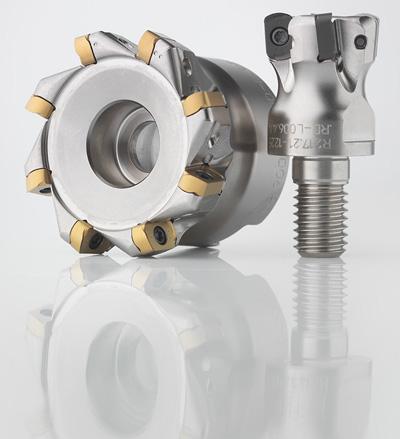
Seco Tools LLC recently expanded its Highfeed series of indexable-insert milling cutters to include the Highfeed 2 and 4. The latest cutters feature new insert designs combined with more teeth per diameter to achieve high speeds and feeds when processing hard and tough workpiece materials.
Dubbed the world's smallest high-feed milling cutter with indexable inserts, Highfeed 2 is perfect for applications that require a high ramping angle or superior plunging performance. It features LP05 single-sided inserts with two cutting edges for cutter bodies that range from 0.5" to 0.75" in diameter. Available in three different geometries (ME, M and MD), these positive LP inserts easily handle sticky materials such as stainless steels, titanium and super alloys. Mounting types include Combimaster heads and cylindrical shanks.
Highfeed 4 features LO06 double-sided inserts with four cutting edges for cutter bodies that range from 1.00" to 2.50" in diameter. Available in four different insert geometries (ME, M, MD and D), these close-pitch and negative-pocket LP inserts cost effectively machine common workpiece materials. Mounting types include Combimaster heads, cylindrical shanks and shell ends.
Seco designed both the Highfeed 2 and 4 cutters to significantly reduce vibrations for smooth, stable cutting and increased productivity. The cutters also efficiently evacuate chips for worry-free operation. Furthermore, Highfeed 2 and 4 cutters truly excel when processing challenging materials at high speeds on smaller machines with high-speed, low-torque spindles.
According to Seco, its Highfeed series of milling cutters, in general, permit up to three times faster machining than conventional methods. They provide shallow depths of cut with high feed per tooth rates to deliver greater metal removal rates for an overall boost in productivity.
Contact Details
Related Glossary Terms
- alloys
alloys
Substances having metallic properties and being composed of two or more chemical elements of which at least one is a metal.
- feed
feed
Rate of change of position of the tool as a whole, relative to the workpiece while cutting.
- gang cutting ( milling)
gang cutting ( milling)
Machining with several cutters mounted on a single arbor, generally for simultaneous cutting.
- milling
milling
Machining operation in which metal or other material is removed by applying power to a rotating cutter. In vertical milling, the cutting tool is mounted vertically on the spindle. In horizontal milling, the cutting tool is mounted horizontally, either directly on the spindle or on an arbor. Horizontal milling is further broken down into conventional milling, where the cutter rotates opposite the direction of feed, or “up” into the workpiece; and climb milling, where the cutter rotates in the direction of feed, or “down” into the workpiece. Milling operations include plane or surface milling, endmilling, facemilling, angle milling, form milling and profiling.
- milling cutter
milling cutter
Loosely, any milling tool. Horizontal cutters take the form of plain milling cutters, plain spiral-tooth cutters, helical cutters, side-milling cutters, staggered-tooth side-milling cutters, facemilling cutters, angular cutters, double-angle cutters, convex and concave form-milling cutters, straddle-sprocket cutters, spur-gear cutters, corner-rounding cutters and slitting saws. Vertical cutters use shank-mounted cutting tools, including endmills, T-slot cutters, Woodruff keyseat cutters and dovetail cutters; these may also be used on horizontal mills. See milling.
- stainless steels
stainless steels
Stainless steels possess high strength, heat resistance, excellent workability and erosion resistance. Four general classes have been developed to cover a range of mechanical and physical properties for particular applications. The four classes are: the austenitic types of the chromium-nickel-manganese 200 series and the chromium-nickel 300 series; the martensitic types of the chromium, hardenable 400 series; the chromium, nonhardenable 400-series ferritic types; and the precipitation-hardening type of chromium-nickel alloys with additional elements that are hardenable by solution treating and aging.

